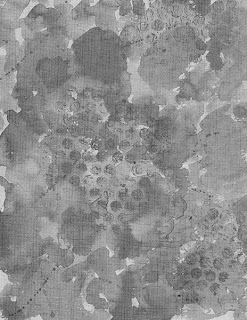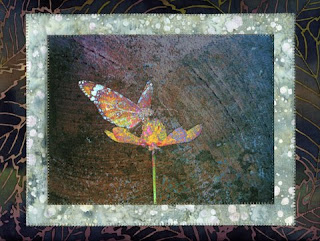Hello! I hope you're all having a wonderful day. It is gray and dreary here but I have lots of fun projects to do inside so I'm not going to let a little thing like the weather get me down (plus I've had too much caffeine...!)

A couple of days ago I wanted to get some fabric ready for a project I have in mind, so I decided to whip up a flour resist. I mixed one cup general purpose wheat flour (not whole wheat) with one cup of cold water together until it was the consistency of pancake batter ("recipe" from Jane Dunnewold's latest book
Art Cloth). I used a whisk to get most of the lumps out. That's as close as I try to get to real cooking!
I had a piece of boring mauve pink hand-dye (batik) pinned to my "print board" (June Tailor "Quilters Cut & Press" with a rotary mat on one side and padded surface on the front). I had an extra piece of muslin wrapped around the padded surface to catch drips but I don't really care if a little paint leaks through.
The batik is approximately 11" x 18" -- larger would be nice, but that fits on the board. Per Jane's directions, I pinned the top of the fabric to the board but left the other three sides loose. I poured about half the flour batter on the fabric and used an old credit card to smooth the resist into a fairly thin layer -- just thick enough so the underlying color was barely visible, but not as thick as frosting between layers of a cake. :-) Half a batch would have been perfect for a piece of fabric that size.
The fabric stretches quite a bit when the resist is applied, but then shrinks considerably as it dries. I used those large "quilters pins" and some of them bent by the time everything was dry!
I let the fabric dry overnight and then got ready to paint.
The fabric was quite stiff and the resist felt like a sheet of egg shells -- cool but a little difficult to work with. I held the fabric over a trash can to catch any bits of resist, but very little actually came off. I scrunched it quite a bit to get it to crackle -- Jane warns against being too aggressive and I can see why. Fine hairline cracks will yield the most interesting texture but I crunched until I could see the fabric in a few places.
I used three colors of Dye-Na-Flow fabric paint: magenta, cranberry red and claret. I picked that paint because it is very thin (watery) but highly saturated so it should work its way into all the nooks and crannies. I worked it in to the resist and made sure the surface got thoroughly wet. Here's what it looks like from the front:

The paint takes about 2 weeks to air cure (possibly less since there isn't as much binder in this particular paint). The flour will wash out, but since I can't really heat-set the fabric with the flour on it, we'll just have to wait. Here is what the back looks like -- you can tell where I went overboard scrunching. I really worked the paint in, but it spread under the resist in the open areas more than I expected:

It is a fun process and I'm looking forward to doing it again soon. It definitely isn't instant gratification, though!
 Hi, All! We had a couple of reasonably warm days earlier in the week (considering it is winter in Central Oregon, so above freezing during the day!) and I played at my workbench making the kraft paper background above. It was the wrapping on a wonderful piece of hand-made paper!
Hi, All! We had a couple of reasonably warm days earlier in the week (considering it is winter in Central Oregon, so above freezing during the day!) and I played at my workbench making the kraft paper background above. It was the wrapping on a wonderful piece of hand-made paper! Since the result was so magical, I call it "Alchemy." If you look closely, you will see bits of writing layered in -- I used a bit of text from an old alchemy manual (Wikimedia Commons) and a scrap of a letter written in a foreign language I got as a freebie somewhere along the way. How cool is that? I have printed the image several times on photofabric and want to turn it into a small art quilt. Stay tuned!
Since the result was so magical, I call it "Alchemy." If you look closely, you will see bits of writing layered in -- I used a bit of text from an old alchemy manual (Wikimedia Commons) and a scrap of a letter written in a foreign language I got as a freebie somewhere along the way. How cool is that? I have printed the image several times on photofabric and want to turn it into a small art quilt. Stay tuned!

















